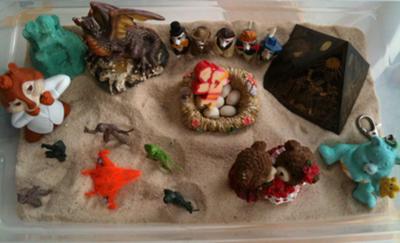If you’re looking for a creative and therapeutic approach to mental health, look no further than sand tray therapy. This unique form of therapy uses a small sandbox to help people explore their thoughts and feelings. It can be used to treat a variety of mental health issues, including anxiety, depression, and PTSD. In this blog post, we will discuss the benefits of sand tray therapy and how it can help improve your mental health!
Contents
What Is Sand Tray Therapy?
 Sand tray therapy is described as a form of psychological therapy that uses a sandbox and miniature toys to help people explore their feelings, thoughts, and emotions. The therapist will usually start by asking the client about their week or what is going on in their life.
Sand tray therapy is described as a form of psychological therapy that uses a sandbox and miniature toys to help people explore their feelings, thoughts, and emotions. The therapist will usually start by asking the client about their week or what is going on in their life.
The client will then choose a scene to build in the sand tray. This can be anything from a beach scene to a cityscape. It is up to the client to decide what they want to build. The therapist will then help the client interpret their scene.
Sand tray therapy is a creative and therapeutic approach to mental health that can be used by people of all ages. It is a non-verbal way of communicating and can be helpful for those who have difficulty expressing themselves verbally. If you are looking for a creative and therapeutic way to explore your feelings, thoughts, and emotions, sand tray therapy may be right for you.
How Does It Work?
Sand tray therapy works by providing a person with a miniature landscape, complete with tiny houses, trees, people, and animals. The therapist then helps the client create scenes in the sand that represent their inner thoughts and feelings. This can be done by talking about the scene as it’s being created or by simply allowing the client to express themselves through the sand tray.
During the session, the therapist will often ask questions about what the client is creating and why. This helps the client to process their thoughts and feelings, and to gain a better understanding of themselves. More often it is seen that as the client is creating their scene, they will start to notice things about themselves that they were not previously aware of.
A therapist may also use sand tray therapy to help a client who is struggling with a particular issue or problem. By working through the problem in the sand tray, the client can often find new solutions and ways of dealing with their issues.
Sand tray therapy is a creative and therapeutic approach to mental health that can be used to help people of all ages. If you think sand tray therapy might be right for you, talk to your therapist about it.
What Techniques Are Used In Sand Tray Therapy?
 There are a few different techniques that therapists use in sand tray therapy. Some common techniques include:
There are a few different techniques that therapists use in sand tray therapy. Some common techniques include:
Sensory Integration
This technique uses the senses to help the individual feel more comfortable and relaxed. This can be done by using different textures of sand, different colors of sand, or even scented sand. For example, it has been shown that the smell of lavender can help to relax an individual.
Focusing
This technique helps the individual focus on one task at a time. It can be helpful for individuals who may have difficulty focusing on one task or who tend to feel overwhelmed easily. For example, a person with ADHD may find it difficult to sit down and complete a task, but by using sand tray therapy they can focus on one task at a time.
Narrative therapy
In this technique, therapists help patients understand their life stories and how they can change the narrative to improve their lives. This is done by exploring past experiences and emotions associated with them in order to help patients see how those events have shaped their lives.
Check our Free Online Therapy App
Symbolic modeling
It is based on the principle that humans are symbolic creatures and that our lives are a series of models or representations of our innermost thoughts, feelings, and emotions. It works through the process of symbolization, which is the ability to understand and communicate through symbols. Many people have found sand tray therapy to be an effective way to heal from trauma, resolve inner conflict, and explore their creative side.
Sand tray therapy is a type of expressive therapy that uses sand and miniature objects to help people express themselves and work through personal issues. The above-mentioned are some of the techniques that are widely used in this type of therapy. If you are looking for a creative and therapeutic approach to mental health, consider sand tray therapy.
What Conditions It Can Help With?
 Sand tray therapy is helpful for a wide range of mental health conditions. Some of the conditions that a sand tray can help with include:
Sand tray therapy is helpful for a wide range of mental health conditions. Some of the conditions that a sand tray can help with include:
- Anxiety
- Depression
- PTSD
- OCD
- Eating disorders
- Addictions
- Anger management issues
- Relationship difficulties
- Grief and loss
It can be used with children, adolescents, and adults. It is a flexible approach that can be adapted to meet the needs of different clients. The conditions that are discussed above are just a few of the many conditions that this type of therapy can help with.
It helps in various conditions by providing a creative outlet that can be used to express thoughts and feelings that might be difficult to put into words. Despite these limitations, it is considered a valuable tool that can be used to help people of all ages.
Are Sand Play And Sand Tray Different?
Sometimes people ask if there is a difference between sand play and sand tray therapy. The simple answer is that sand play is more childlike, while sand tray therapy is more therapeutic. So, both sand play and sand tray are different in various ways. Let’s discuss the differences between the two approaches.
Sand play is a form of therapy that uses sand to help people heal from trauma or work through difficult emotions. The therapist provides a tray of sand and the client can use the sand to create whatever they want. There are no rules or guidelines, and the therapist does not interpret the client’s creations.
On the other hand, sand tray therapy is more technical. The therapist uses a specific tray and the client chooses from an array of miniature figures to create a scene. The therapist then interprets the scene and helps the client work through whatever issue they are dealing with.
So, while both sand play and sand tray therapy are different, both shares the same goal: to help people heal. If you are looking for a creative and therapeutic approach to mental health, consider sand tray therapy. It may be just what you need.
If you have any questions about this type of therapy, please feel free to contact a professional. They will be more than happy to discuss the approach with you and answer any questions you may have.
What Are The Benefits?
 There are many benefits to sand tray therapy, both for the client and the therapist. This type of therapy can be used to address a wide variety of issues, including trauma, anxiety, depression, and relationship problems.
There are many benefits to sand tray therapy, both for the client and the therapist. This type of therapy can be used to address a wide variety of issues, including trauma, anxiety, depression, and relationship problems.
One of the main benefits of this type of therapy is that it allows the client to express themselves in a creative and non-verbal way. This can be particularly helpful for those who have difficulty expressing their emotions verbally.
Another benefit of sand tray therapy is that it can help to build trust between the therapist and the client. This type of therapy requires the therapist to be very present and attuned to the client, which can create a safe and supportive environment.
Finally, sand tray therapy can be a very effective way to promote healing and growth. This type of therapy can help the client to explore their innermost thoughts and feelings and to develop new coping skills.
If you are considering this therapy, or if you are a therapist who is looking for a new approach to mental health, then please contact a professional for the right guidance.
Any Limitations of Sand Tray Therapy?
When something offers you numerous benefits, it is easy to assume that it doesn’t have any limitations. However, this type of therapy does have a few potential limitations that you should be aware of. These include:
- It can be messy: If you are someone who likes things to be neat and tidy, sand tray therapy may not be the right fit for you. The therapist will provide you with a cover for the sand tray, but it is still possible for sand to escape.
- It can be time-consuming: Each session of sand tray therapy lasts for about an hour. This can be a significant time commitment, especially if you are seeing a therapist every week.
- It may not be appropriate for all types of clients: Some people may not feel comfortable with the idea of playing in the sand or may not be able to engage in the necessary level of self-reflection. In these cases, this type of therapy may not be the best approach.
Despite these limitations, sand tray therapy can be an incredibly valuable tool for mental health. If you think it might be right for you, talk to your therapist about giving it a try. Usually, the therapist will be able to tell you if this type of therapy is a good fit for your needs. Therefore, do not let the potential limitations deter you from trying it out.
Conclusion
In conclusion, sand tray therapy is considered to be an effective and creative approach to mental health. It can provide individuals with a way to express themselves, work through their issues, and find relief from their symptoms. This is a safe, non-invasive, and effective way to explore one’s inner thoughts and feelings.
It can be an excellent tool for personal growth and healing. Hence, you are encouraged to give it a try. If you are looking for a sand tray therapist, please contact your local mental health provider. They will be able to help you find a qualified professional in your area.
However, for more information, you can also reach out to Therapy Mantra. Here, the team of professional counselors is more than happy to help you in your journey to recovery. Contact us today to learn more about our services. You can also book an online therapy session or download our free Android or iOS app.


